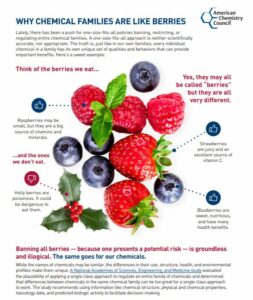Misconceptions about chemical families: the one-size-fits-all approach
The American Chemistry Council (ACC) has recently launched a new educational tool with the aim to explain the misconceptions about chemical families and the impact that this may have in everyday lives.
 ACC explains that its members and the industry are committed to addressing potential concerns about chemicals and supports strong regulations that protect human health and the environment. However, the growing practice of banning, restricting, or regulating entire classes of chemicals, without acknowledging individual properties and behaviors, is neither scientifically accurate nor appropriate.
ACC explains that its members and the industry are committed to addressing potential concerns about chemicals and supports strong regulations that protect human health and the environment. However, the growing practice of banning, restricting, or regulating entire classes of chemicals, without acknowledging individual properties and behaviors, is neither scientifically accurate nor appropriate.
Lately, there has been a trend in one-size-fits-all policies by federal and state policymakers to ban, restrict, or regulate entire chemical families. Reviews and regulations should take into account the significant differences among the many compounds that are part of a chemical family. Rather than using a one-size-fits-all approach, we need a fact-based discussion about the nature of these substances, how they differ from each other and what they do affect – and what they don’t – in terms of human health and the environment.
A one-size-fits-all approach is neither scientifically accurate, nor appropriate. The truth is, just like in our own families, every individual chemical in a family has its own unique set of qualities and behaviors that can provide important benefits.
ONE “SIZE” DOES NOT FIT ALL
Each chemical in a family has its own characteristics. For example, diamonds, charcoal and graphite are all forms of carbon, but have different properties. Yet, a one-size-fits-all approach would group all these forms together. The National Academies confirmed this in a study where they evaluated the plausibility of applying a single class approach to regulate an entire family of chemicals. They recommend using information like chemical structure, physical and chemical properties, toxicology data, and predicted biologic activity as the basis for decision-making.
TAKE INTO ACCOUNT ALL THE EVIDENCE
Broad ultimatums or sweeping assumptions rarely result in good, effective policies. Instead, policies should take into account all scientific evidence, while giving the greatest weight to the most relevant and highest quality studies.
A NOT-SO-SOUND STRATEGY
Even if a chemical has a similar-sounding name, it doesn’t mean it is the same. A sweet example? A sugar maple is not the same as maple sugar.
SAFETY IN NUMBERS
Did you know chemicals are one of the most regulated industries around the world? In the U.S., more than a dozen federal laws and multiple federal agencies govern the safe manufacture and use of chemicals. Governing bodies that recognize various members of a chemical family are different and therefore should be dealt with differently are well positioned to make good science-based policy decisions.
FILLING DATA GAPS
While one-size-fits-all approaches are not scientifically appropriate for regulatory decision-making, a useful way to screen chemicals for further review is called the category or sub-category approach. A category is a group of chemicals whose intrinsic properties are likely to be similar or follow a regular pattern, usually as a result of structural similarity. Such an approach can sometimes be used to help fill any additional information needs, prioritize research, or further assess individual chemicals within a category or subcategory.
For more information
Please check:
https://www.americanchemistry.com/Chemical-Families/
Contact:
American Chemistry Council
Jennifer Garfinkel
(202) 249-6742


